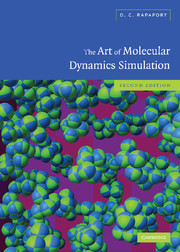Book contents
- Frontmatter
- Contents
- Preface to the first edition
- Preface to the second edition
- About the software
- 1 Introduction
- 2 Basic molecular dynamics
- 3 Simulating simple systems
- 4 Equilibrium properties of simple fluids
- 5 Dynamical properties of simple fluids
- 6 Alternative ensembles
- 7 Nonequilibrium dynamics
- 8 Rigid molecules
- 9 Flexible molecules
- 10 Geometrically constrained molecules
- 11 Internal coordinates
- 12 Many-body interactions
- 13 Long-range interactions
- 14 Step potentials
- 15 Time-dependent phenomena
- 16 Granular dynamics
- 17 Algorithms for supercomputers
- 18 More about software
- 19 The future
- Appendix
- References
- Function index
- Index
- Colophon
7 - Nonequilibrium dynamics
Published online by Cambridge University Press: 28 February 2011
- Frontmatter
- Contents
- Preface to the first edition
- Preface to the second edition
- About the software
- 1 Introduction
- 2 Basic molecular dynamics
- 3 Simulating simple systems
- 4 Equilibrium properties of simple fluids
- 5 Dynamical properties of simple fluids
- 6 Alternative ensembles
- 7 Nonequilibrium dynamics
- 8 Rigid molecules
- 9 Flexible molecules
- 10 Geometrically constrained molecules
- 11 Internal coordinates
- 12 Many-body interactions
- 13 Long-range interactions
- 14 Step potentials
- 15 Time-dependent phenomena
- 16 Granular dynamics
- 17 Algorithms for supercomputers
- 18 More about software
- 19 The future
- Appendix
- References
- Function index
- Index
- Colophon
Summary
Introduction
In the study of equilibrium behavior, MD is used to probe systems that, at least in principle, are amenable to treatment by statistical mechanics. The fact that statistical mechanics is generally unable to make much headway without resorting to simplification and approximation is merely a practical matter; the concepts and general relationships are extremely important even in the absence of closed-form solutions. When one departs from equilibrium, very little theoretical guidance is available and it is here that MD really begins to fill the role of an experimental tool.
There are many nonequilibrium phenomena worthy of study, but MD applications have so far tended to concentrate on relatively simple systems, and the case studies in this chapter will focus on the simplest of problems. To be more specific, we will demonstrate two very different approaches to questions related to fluid transport. The first approach uses genuine Newtonian dynamics applied to spatially inhomogeneous systems, in which the boundaries play an essential role: simulations of fluids partly constrained by hard walls will be used to determine both shear viscosity and thermal conductivity. The second approach is based on a combination of modified equations of motion and fully homogeneous systems: the same transport coefficients will be measured, but since there are no explicit boundaries the dynamics must be altered in very specific ways to compensate for their absence.
Homogeneous and inhomogeneous systems
As computational tools, both homogeneous and inhomogeneous nonequilibrium methods have their strengths and weaknesses.
- Type
- Chapter
- Information
- The Art of Molecular Dynamics Simulation , pp. 176 - 198Publisher: Cambridge University PressPrint publication year: 2004



